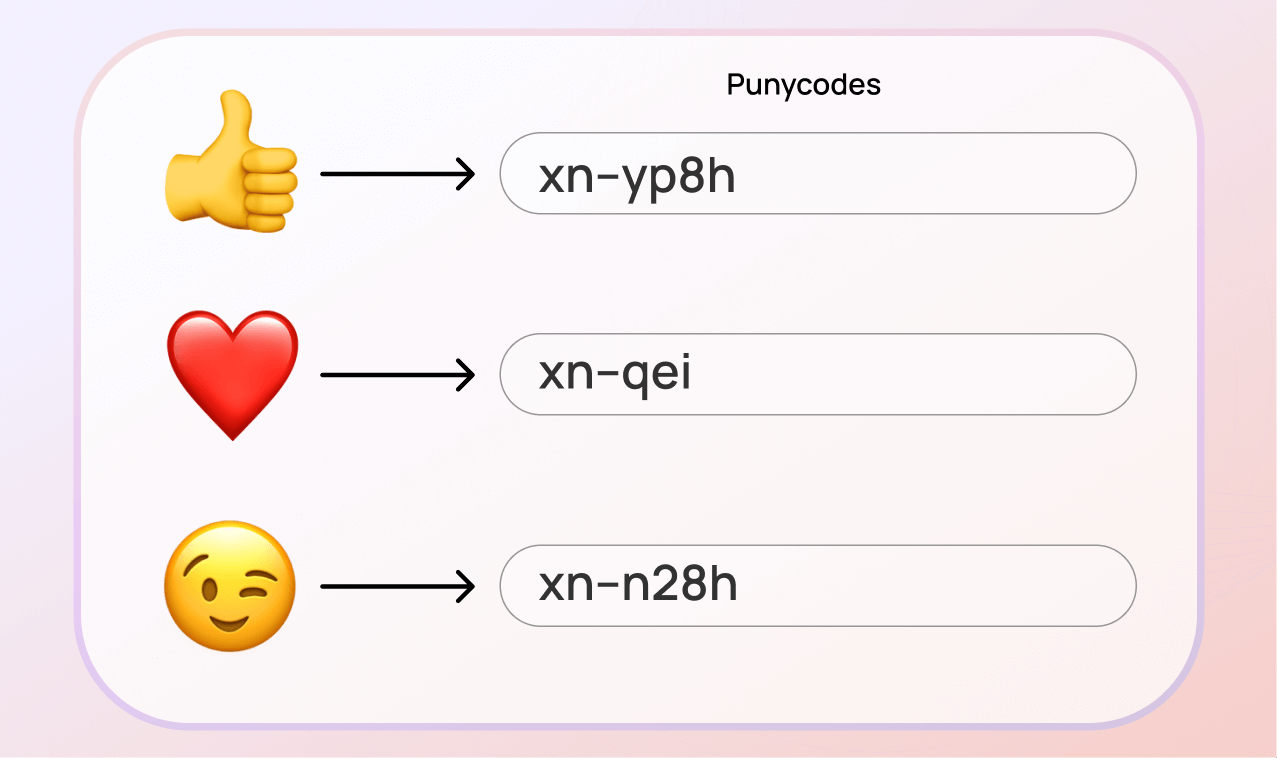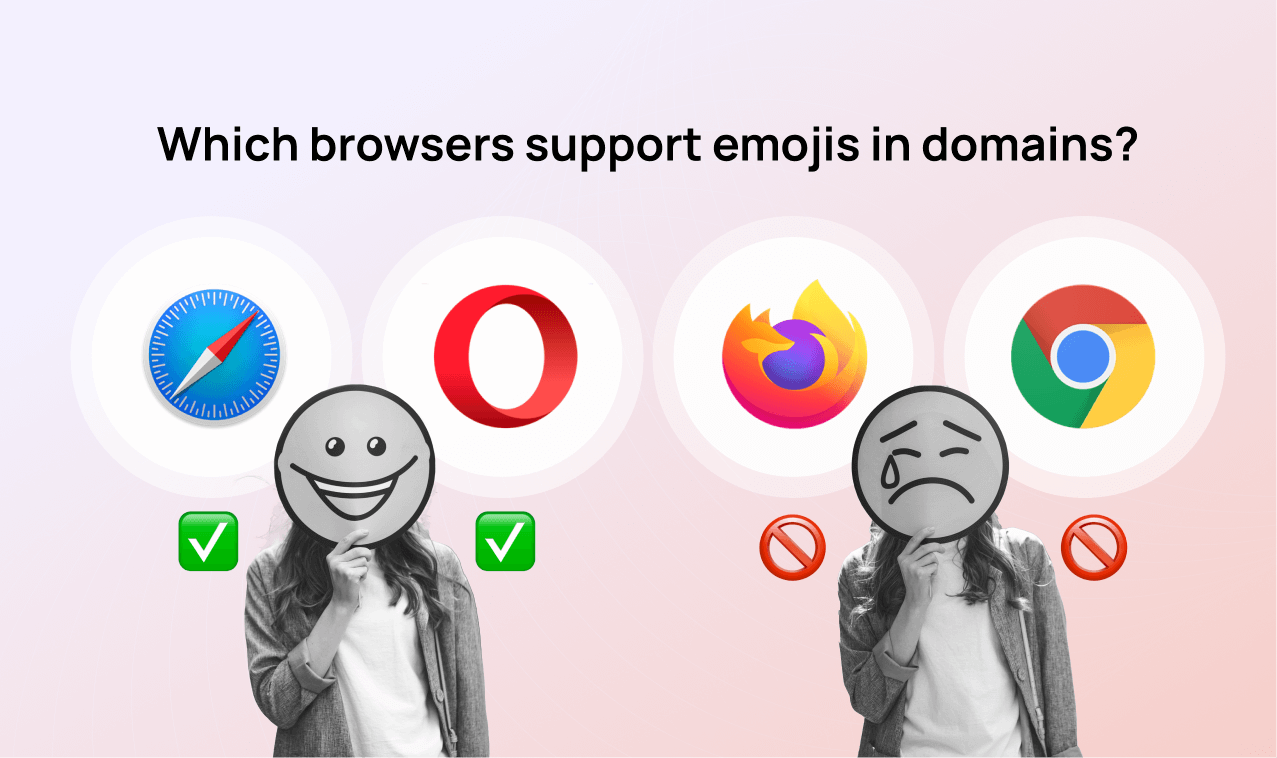
Emoji domains | Yay or nay?

The Internet is constantly changing and the possibilities for designing domains have become more diverse as a result. One of these possibilities is the integration of emojis into domain names, which comes with both advantages and disadvantages.
Published by

Simone Catania
Date
Emojis have become an integral part of our digital communication and it is hard to imagine our everyday lives without them. In recent years, the little colorful faces, objects and symbols have also found their way into the world of domains. In this article, we take a closer look at this trend, starting with the definition of emojis through to the opportunities and risks they entail for registrants.
What are emojis?
Emojis are small symbols or pictograms that are used to express emotions, ideas, objects and much more. The origins of emojis date back to the 1990s in Japan, when engineer Shigetaka Kurita developed the first 176 emojis for a mobile internet portal.
Since then, emojis have had a profound influence on how we express ourselves and how messages are interpreted. They not only help to improve emotional expression, but also promote a playful and positive atmosphere in online communication. So wouldn’t emojis actually be perfect for online businesses and expressive domain names? The answer is not straighforwards as the use of emojis in domains is not quite as simple as it seems at first glance.
Emoji domains – how are they used?
The use of emojis in domains makes it possible to design internet addresses in a whole new way. Instead of traditional letters and numbers, domains can contain emojis that represent the company, website or theme of the homepage in a creative and eye-catching way. For example, a pizzeria could add an emoji for pizza to their homepage domain to immediately create a visual association with the business.
Conversion to Punycode
Domains with emojis must first be converted based on the Punycode encoding. This is done using ASCII encoding, an international standard that converts non-ASCII characters, such as emojis, into an ASCII character string that can be used in the DNS and browsers. The abbreviation for Unicode ASCII stands for American Standard Code for Information Interchange. Each emoji is therefore converted into a sequence of characters that can be understood by computers. This process is called punycode conversion and is necessary to ensure that the domain can be resolved correctly. Each emoji has a unique punycode. For example, 😉 becomes xn--n28h. Emoji subdomains are also possible.

In 2003, ICANN (Internet Corporation for Assigned Names and Numbers) introduced a technical option for registering domains with umlauts, diacritical characters or letters from alphabets other than the Latin alphabet. Originally, this was not provided for in the DNS and was subsequently made possible by the Internet standard Internationalising Domain Names in Applications (IDNA) via RFC 5892. This also cleared the way for emojis to enter the domain space.
The first three domains with emojis were reserved on 21 April 2001. ♨️.com with xn--j6h.com, ♨️.net with xn--j6h.net and ☮️.com with xn--v4h.com.
Pros and cons of emojis domains
The integration of emojis into domains offers some exciting benefits and a wide variety of creative possibilities. Companies can personalize their domains with symbolic emojis to strengthen their branding and brand perception.
- Branding
Emojis can help to strengthen brand identification and recognition as they are eye-catching and memorable.- Internationality
Emojis are universal and understood by people all over the world, making communication easier.- Creativity
Companies can create creative domains that better suit their products or services.- Awareness
Emojis create awareness among users and can help to increase the click-through rate.
Technical problems and risks with emoji domains
However, emojis in domains are also associated with some challenges and technical risks.
At present, the biggest problem is the small number of registries and registrars that support these domains. The same applies to browsers. Not all of them display the emojis correctly in the search bar. For example, Google Chrome (currently the most widely used browser in Germany) and Firefox encode the emoji directly in the Punycode and only display this encoding. Consequently, the emoji disappears. In Safari and Opera, on the other hand, the emoji remains visible in the browser line.

Registering an emoji domain is also more difficult than with conventional domains. It is not possible to apply directly to the registry for such a domain. The emoji domain must first be converted into a Punycode. It can then be set up on the name server, whereby care must be taken to enter the Punycode correctly.
Emoji domains can also lead to confusion among users. With almost 4,000 emojis available, this is not surprising. There are numerous similar-looking emojis or some that can be interpreted ambiguously. Most platforms or services such as browsers or email clients still do not support emoji domains or restrict their use. As a result, the practical functionality and applicability of emojis in domain names dissipates.
Emoji domains only for some ccTLDs
Currently, only 11 top-level domains allow the registration of emojis in the domain: .cf, .fm, .ga, .gq, .kz, .ml, .st, .tk, .to, .uz, and . ws, as well as 14 second-level domains: .radio.am, .radio.fm, .co.il, .org.il, .com.kz, .org.kz, .biz.ua, .co.ua, .pp.ua, .co.uz, .com.uz, .com.ws, .net.ws, and .org.ws.
Although ccTLDs are not subject to ICANN policies and can therefore allow emojis as part of domains, users should carefully consider the potential risks and uncertainties associated with emoji domains before deciding to use them.
ICANN is responsible for managing and coordinating the DNS. The organization has been critical of emojis in domains, calling it a “security risk for all“. But why?
IDNA 2008, the current standard for internationalized domains, prohibits emojis in domains (RFC 5892). For this reason, applications or organizations that strictly adhere to the standard do not support emojis – others process them inconsistently. ICANN also states that the use of emojis in domains poses problems for end users.
- Technical complexity
The Punycode conversion can lead to technical challenges and make handling the domains more difficult.- Lack of implementation
Not every browser supports domains with emojis, which can lead to compatibility issues.- Misuse
Emojis can also be misused to cause confusion or lure users to malicious websites.- Confusion
Many emojis are only slightly different from each other, so similar-looking emojis could lead to confusion.- Security problems
The integration of emojis can pose potential security issues, as in some cases they could be used to disguise phishing websites.
What are brands, organizations and registrars doing?
Some world-famous brands have already jumped on the emoji domain bandwagon. Coca-Cola, for example, used an emoji domain, 🎅🏼.ws, for its Christmas campaign to encourage interaction with customers and strengthen its brand presence. As not all TLDs allow emoji domains, Coca-Cola opted for .ws, the official extension of Samoa. The ending is intended to stand for “we smile”.
The fast food chain Burgerking is also employing the emoji domain 🍔👑.to for an advertising campaign.
These examples show that emoji domains are creative ways to draw attention to marketing campaigns, increase brand awareness and encourage customer interaction. But is attention the only thing emoji domains can deliver?
“Emoji domains have some interesting advantages that can make them attractive, especially in the area of marketing and personal expression. Despite these benefits, there are also challenges and limitations associated with the use of emoji domains, such as technical compatibility issues and the potential for confusion when entering the domain. It is therefore important to carefully weigh up the pros and cons before deciding on an emoji domain.”
Marco Hoffmann, Head of Domain Services InterNetX
What does the future hold for emoji domains?
The future of emojis in domains remains uncertain, but they definitely offer exciting possibilities for internet address design among the few TLDs that support them. How the technology and regulators respond to the challenges involved will be critical. Businesses and website operators should be aware that the use of emojis in domains is not without risks and that they should be implemented with caution and accompanied by adequate security measures.
Overall, emojis in domains offer an interesting opportunity to promote creativity and brand identification, but they should be used with caution and with technical and security considerations in mind.
The internet landscape is constantly evolving and emojis in domains are just one of the many exciting developments. It remains to be seen how this technology will evolve, catch on and influence the way we use and perceive the internet.
Alternatives to emoji domains
Emoji domains are not the only way to get creative on the Internet. Our portfolio of 1,050+ TLDs offers you almost unlimited possibilities. If your desired domain is already taken, there are still options to register a perfect domain match. Emoji domains can also be used as a supplement within a multi-domain strategy.
“The introduction of emoji domains has added an exciting dimension to marketing strategies for brands. Emojis, as visual representations, have a communicative power that goes beyond traditional domains. By combining regular characters with emoji Punycode, companies can create unique and customised domains. However, the use of emojis harbours challenges. There is still a lack of technical representation in browsers and emojis often have double meanings. In addition, certain emojis are very similar to each other, which harbours the risk of accidental registration errors. .ws is one of the few TLDs that allow emoji domain registrations, which greatly limits the choice of TLDs.”
Claus Barche, Head of Sales InterNetX
Another way to make your domain stand out is with creative and clever domain hacks – a clever way of using the name and extension of a domain to form a word or phrase, such as stern.tv, a well-known German brand. The TLD is used in such a way that it becomes part of the actual name and lends additional meaning or creativity. For example, the TLD .tv fits perfectly to form stern.tv. .me, the country-specific TLD .me actually belongs to Montenegro. The Universal Pictures franchise Despicable Me uses the TLD to creatively market its cinema films “I – Simply Incorrigible” and “Minions” under despicable.me. The TLDs with ambiguous usages can generate numerous domain hacks.
Find perfect domains
Are you still looking for the perfect domain? AutoDNS gives you unlimited options –- including emoji domains.






